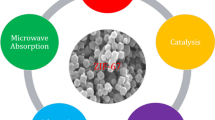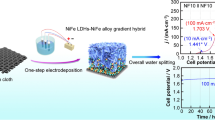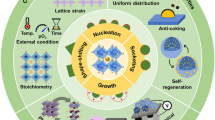Abstract
In the article, we reported two-dimensional nanoscale MoS2 has been demonstrated to possess intrinsic catalytic activity for thermal decomposition of dihydroxylammonium-5,5′-bistetrazole-1,1′-diolate (TKX-50). The morphology and structure of MoS2 nanosheets prepared by liquid ultrasonic exfoliation were characterized by scanning electron microscopy, powder X-ray diffraction, X-ray photoelectron spectroscopy, and Raman spectra. Thermal catalysis decomposition was investigated by thermogravimetric/differential scanning calorimetry. MoS2 was added to TKX-50, and the results show that nano-MoS2 can decrease the activation energy of TKX-50 decomposition from 220.0 to 140.6 kJ mol−1 effectively and that the decomposition temperature was decreased by 32.1 °C more than 23.8 °C for commercial bulk MoS2. In addition, a possible mechanism of MoS2 towards the catalysis thermal decomposition of TKX-50 was proposed. The conduction-band electrons (e −cb ) and valence-band holes (h+) excited on the surface of MoS2 under thermal excitation promoted H+ transfer from H atom of NH3OH+ to O atom of bisteterazole and boosted the decomposition of TKX-50 further. This work may offer a new idea to introduce transition metal dichalcogenide into thermal catalysis fields.





Similar content being viewed by others
References
Jaramillo TF, Jorgensen KP, Bonde J, Nielsen JH, Horch S, Chorkendorff IB. Identification of active edge sites for electrochemical H2 evolution from MoS2 nanocatalysts. Science. 2007;317(5834):100–2.
Zhang G, Liu H, Qu J, Li J. Two-dimensional layered MoS2: rational design, properties and electrochemical applications. Energy Environ Sci. 2016;9:1190–209.
Lei J, Guo Q, Yin D, Gui X, He R, Duan T, Zhu W. Bioconcentration and bioassembly of N/S co-doped carbon with excellentstability for supercapacitors. Appl Surf Sci. 2019;488:316–25.
Wang L, Qu X, Zhao Y, Weng Y, Waterhouse GIN, Yan H, Guan S, Zhou S. Exploiting single atom iron centers in a porphyrin-like MOF for efficient cancer phototherapy. ACS Appl Mater Int. 2019;11:35228–37.
Rychlowska-Himmel I. Phase equilibria in the system Fe2O3–V2O5–WO3 in the solid state. J Therm Anal Calorim. 2000;60:173–6.
Ghatak S, Pal AN, Ghosh A. Nature of electronic states in atomically thin MoS2 field-effect transistors. ACS Nano. 2011;5(10):7707–12.
Yin Y, Han J, Zhang Y, Zhang X, Xu P, Yuan Q, Samad L, Wang X, Wang Y, Zhang Z, Zhang P, Cao X, Song B, Jin S. Contributions of phase, sulfur vacancies, and edges to the hydrogen evolution reaction catalytic activity of porous molybdenum disulfide nanosheets. J Am Chem Soc. 2016;138:7965–72.
Wang Y, Wilkinson D, Zhang J. Noncarbon support materials for polymer electrolyte membrane fuel cell electrocatalysts. Chem Rev. 2011;111:7625–51.
Vadivelmurugan A, Anbazhgan R, Tsai HC. Preparation of fluorescent MoS2 quantum dots conjugated with various ligands, and its fluorescence imaging. Mater Lett. 2018;218:285–9.
Chen W, Chang L, Ren S, He Z, Huang G, Liu XH. Direct Z-scheme 1D/2D WO2.72/ZnIn2S4 hybrid photocatalysts with highly-efficient visible-light-driven photodegradation towards tetracycline hydrochloride removal. J Hazard Mater. 2019;384:121208.
Chen J, He S, Huang B, Wu P, Qiao Z, Wang J, Zhang L, Yang G, Huang H. Enhanced thermal decomposition properties of CL-20 through space-confining in three-dimensional hierarchically ordered porous carbon. ACS Appl Mater Int. 2017;9(12):10684–91.
Li Q, He Y, Peng R. Graphitic carbon nitride (g-C3N4) as a metal-free catalyst for thermal decomposition of ammonium perchlorate. RSC Adv. 2015;5:24507–12.
Deng P, Ren H, Jiao Q. Enhanced the combustion performances of ammonium perchlorate-based energetic molecular perovskite using functionalized graphene. Vacuum. 2019;169:108882.
Zhang J, Zhao F, Yang Y, Yan Q, Zhang M, Ma W. Enhanced catalytic performance on the thermal decomposition of TKX-50 by Fe3O4 nanoparticles highly dispersed on rGO. J Therm Anal Calorim. 2018. https://doi.org/10.1007/s10973-019-08891-5.
Cheng J, Yan J, Wang L, Zhang R, Liu Z, Wang R, Li Z. Functionalization graphene oxide with energetic groups as a new family of metal-free and energetic burning rate catalysts and desensitizers for ammonium perchlorate. J Therm Anal Calorim. 2019. https://doi.org/10.1007/s10973-019-08938-7.
Lei J, Liu H, Yin D, Zhou L, Liu J-A, Chen Q, Cui X, He R, Duan T, Zhu W. Boosting the loading of metal single atoms via a bioconcentration strategy. Small. 2020;1905920. https://doi.org/10.1002/smll.201905920.
Wang L, Guan S, Weng Y, Xu S, Lu H, Meng X, Zhou S. Highly efficient vacancy-driven photothermal therapy mediated by ultrathin MnO2 nanosheets. ACS Appl Mater Interfaces. 2019;11:6267–75.
Deng P, Ren H, Jiao Q. Enhanced thermal decomposition performance of sodium perchlorate by molecular assembly strategy. Ionics. 2019. https://doi.org/10.1007/s11581019033010.
Deng P, Xu J, Li S, Huang S, Zhang H, Wang J, Liu Y. A facile one-pot synthesis of monodisperse hollow hexanitrostilbene-piperazine energetic compound microspheres. Mater Lett. 2018;214:45–9.
Bari R, Denton AA, Fondren ZT, McKenna GB, Simon SL. Acceleration of decomposition of CL-20 explosive under nanoconfinement. J Therm Anal Calorim. 2019. https://doi.org/10.1007/s10973-019-09027-5.
Cao X, Shang Y, Meng K, Yue G, Yang L, Liu Y, Deng P, Hu L. Fabrication of three-dimensional TKX-50 network-like nanostructures by liquid nitrogen-assisted spray freeze drying method. J Energ Mater. 2019;37:356–64.
Cao X, Yang L, Wang H, Shang Y, Hu S, Deng P, Hu L. Thermal decomposition and combustion characteristics of TKX-50 with network nanostructure fabricated by rapid freeze-drying method. Chin J Energ Mater. 2018;26(12):1044–8.
Cao X, Deng P, Hu S, Ren L, Li X, Xiao P, Liu Y. Synthesis and characterization of energetic hollow spherical hexanitro-stilbene derivatives. Nanomaterials. 2018;8:336.
Jia Q, Deng P, Li X, Hu L, Cao X. Insight into the thermal decomposition properties of potassium perchlorate (KClO4)-based molecular perovskite. Vacuum. 2020;175:109257.
Deng P, Wang H, Yang X, Ren H, Jiao Q. Thermal decomposition and combustion performance of high-energy ammonium perchlorate-based molecular perovskite. J Alloy Compd. 2020;154257. https://doi.org/10.1016/j.jallcom.2020.154257.
Deng P, Jiao Q, Ren H. Synthesis of nitrogen-doped porous hollow carbon nanospheres with a high nitrogen content: A sustainable synthetic strategy using energetic precursors. Sci Total Environ. 2020;714:136725.
Deng P, Jiao Q, Ren H. Nano dihydroxylammonium 5,5′-bistetrazole-1,1′-diolate (TKX-50) sensitized by the liquid medium evaporation-induced agglomeration self-assembly. J Energ Mater. 2019. https://doi.org/10.1080/07370652.2019.1695018.
Li X, Hu S, Cao X, Hu L, Deng P, Xie Z. Ammonium perchlorate-based molecular perovskite energetic materials: preparation, characterization, and thermal catalysis performance with MoS2. J Energ Mater. 2019. https://doi.org/10.1080/07370652.2019.1679281.
Deng P, Liu Y, Luo P, Wang J, Liu Y, Wang D, He Y. Two-steps synthesis of sandwich-like graphene oxide/LLM-105 nanoenergetic composites using functionalized graphene. Mater Lett. 2017;194:156–9.
Jia Q, Bai X, Zhu S, Cao X, Deng P, Hu L. Fabrication and characterization of nano (H2dabco)[K(ClO4)3] molecular perovskite by ball milling. J Energ Mater. 2019. https://doi.org/10.1080/07370652.2019.1698675.
Hu L, Liu Y, Hu S, Wang Y. 1T/2H multi-phase MoS2 heterostructures: synthesis, characterization and thermal catalysis decomposition of dihydroxy-lammonium 5,5′-bistetrazole-1,1′-diolate. New J Chem. 2019;43:10434–41.
Wang J, Chen S, Jin S, Shi R, Yu Z, Su Q, Ma X, Zhang C, Shu Q. The primary decomposition product of TKX-50 under adiabatic condition and its thermal decomposition. J Therm Anal Calorim. 2018;134:2049–55.
Jia J, Liu Y, Huang S, Xu J, Li S, Zhang H, Cao X. Crystal structure transformation and step-by-step thermal decomposition behavior of dihydroxylammonium 5,5′-bistetrazole-1,1′-diolate. RSC Adv. 2017;7:49105–13.
Najmaei S, Liu Z, Ajayan PM, Lou J. Thermal effects on the characteristic Raman spectrum of molybdenum disulfide (MoS2) of varying thicknesses. Appl Phys Lett. 2012;1:1271–4.
Helveg S, Lauritsen JV, Lægsgaard E, Stensgaard I, Norskov JK, Clausen BS, Topsoe H, Besenbacher F. Atomic-scale structure of single-layer MoS2 nanoclusters. Phys Rev Lett. 2000;84:951–4.
Sreeprasad T, Nguyen P, Kim N, Berry V. Controlled, defect-guided, metal-nanoparticle incorporation onto MoS2 via chemical and microwave routes: electrical, thermal, and structural properties. Nano Lett. 2013;13(9):4434–41.
Zheng W, Lin J, Feng W, Xiao K, Qiu Y, Chen X, Liu G, Cao W, Pantelides S, Zhou W, Hu P. Patterned growth of P-type MoS2 atomic layers using sol–gel as precursor. Adv Funct Mater. 2016;26:6371–9.
Tang S, Wu W, Zhang S, Ye D, Zhong P, Li X, Liu L, Li Y. Tuning the activity of the inert MoS2 surface via graphene oxide support doping towards chemical functionalization and hydrogen evolution: a density functional study. Phys Chem Chem Phys. 2018;20:1861–71.
Li Q, He Y, Peng R. One-step synthesis of SnO2 nanoparticles-loaded graphitic carbon nitride and their application in thermal decomposition of ammonium perchlorate. New J Chem. 2015;39:8703–7.
Acknowledgements
This work was supported by Natural Science Foundation of China (No: 21975227) and project supported by Sichuan Public Security Bureau (Grant No. 201903).
Author information
Authors and Affiliations
Corresponding authors
Ethics declarations
Conflicts of interest
There are no conflicts to declare.
Additional information
Publisher's Note
Springer Nature remains neutral with regard to jurisdictional claims in published maps and institutional affiliations.
Electronic supplementary material
Below is the link to the electronic supplementary material.
Rights and permissions
About this article
Cite this article
Li, X., Cao, X., Bai, X. et al. Two-dimensional nanoscale MoS2 for thermal catalysis of dihydroxylammonium-5,5′-bistetrazole-1,1′-diolate (TKX-50). J Therm Anal Calorim 143, 3003–3008 (2021). https://doi.org/10.1007/s10973-020-09432-1
Received:
Accepted:
Published:
Issue Date:
DOI: https://doi.org/10.1007/s10973-020-09432-1




